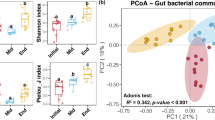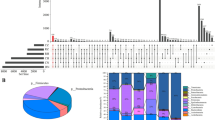Abstract
Accumulating evidence demonstrates that it is of great importance to maintain a stable and functional gut microbial community for host’s growth and health. However, gut microenvironment is constantly affected by diverse environmental factors. Salinity can cause stress, including hypersaline or hyposaline stress to aquatic species, thereby affecting their growth conditions. Razor clam (Sinonovacula constricta), an economically important bivalve species, inhabits in intertidal and estuarine zones and constantly experiences salinity stress. Yet little is known about how and to what extent clam gut microbiota is affected by salinity stress, while this knowledge is fundamental for clam aquaculture health management. To address this concern, this study compared the temporal differences of gut bacterial signatures and community assembly of S. constricta under normal salinity (NS), low salinity (LS), and high salinity (HS) conditions. Acute salinity stress affected the compositions, structures, and functional potentials of clam gut microbial community, of which salinity stress, hours post stress, and their interaction respectively constrained 7.6%, 16.4%, and 7.9% of community variation. Phylogenetic bin-based null model result revealed that the gut bacterial assembly of three salinity groups seemed to be largely driven by stochastic processes. Network analysis indicated that gut bacterial interspecies interaction exhibited less connected and lower cooperative activity under the conditions of LS and HS compared with NS. Notably, some pathogenic bacteria, including Vibrio and Pseudoalteromonas, were identified as keystone taxa of gut microbial networks in LS and HS groups. Above findings suggest that the clams under LS and HS conditions might be at a higher risk of developing disease. Our findings enhance the mechanism understanding of gut microbial assembly in S. constricta under abiotic factor challenge, which has important implications for clam health control from a microbial ecological perspective.






Similar content being viewed by others
Availability of Data and Material
The raw data analyzed in this study have been deposited in the NCBI Sequence Read Archive (SRA) database under BioProject accession number PRJNA1025332.
References
Anderson MJ, Willis TJ (2003) Canonical analysis of principal coordinates: a useful method of constrained ordination for ecology. Ecology 84:511–525
Cao W, Bi S, Chi C, Dong Y, Xia S, Liu Z, Zhou L, Sun X, Geng Y, Wu B (2022) Effects of high salinity stress on the survival, gill tissue, enzyme activity and free amino acid content in razor clam Sinonovacula constricta. Front Mar Sci 9:131
Chen Y, Ye B, Niu D, Li J (2021) Changes in metabolism and immunity in response to acute salinity stress in Chinese razor clams from different regions. Aquacult Rep 19:100624
Churchill GA (2004) Using ANOVA to analyze microarray data. Biotechniques 37:173–175
Clerissi C, De Lorgeril J, Petton B, Lucasson A, Escoubas JM, Gueguen Y, Dégremont L, Mitta G, Toulza E (2020) Microbiota composition and evenness predict survival rate of oysters confronted to Pacific oyster mortality syndrome. Front Microbiol 11:311
Dai W, Zhang J, Qiu Q, Chen J, Yang W, Ni S, Xiong J (2018) Starvation stress affects the interplay among shrimp gut microbiota, digestion and immune activities. Fish Shellfish Immu 80:191–199
Dai W, Sheng Z, Chen J, Xiong J (2020) Shrimp disease progression increases the gut bacterial network complexity and abundances of keystone taxa. Aquaculture 517:734802
Dai W, Dong Y, Ye J, Xue Q, Lin Z (2022) Gut microbiome composition likely affects the growth of razor clam Sinonovacula constricta. Aquaculture 550:737847
Dai W, Ye J, Xue Q, Liu S, Xu H, Liu M, Lin Z (2023) Changes in bacterial communities of kumamoto oyster larvae during their early development and following Vibrio infection resulting in a mass mortality event. Mar Biotechnol 25:30–44
Deng Y, Jiang YH, Yang Y, He Z, Luo F, Zhou J (2012) Molecular ecological network analyses. BMC Bioinformatics 13:113
Destoumieux-Garzón D, Canesi L, Oyanedel D, Travers MA, Charrière GM, Pruzzo C, Vezzulli L (2020) Vibrio-bivalve interactions in health and disease. Environ Microbiol 22:4323–4341
Diaz F, Farfan C, Sierra E, Re AD (2001) Effects of temperature and salinity fluctuation on the ammonium excretion and osmoregulation of juveniles of Penaeus vannamei, Boone. Mar Freshw Behav Phy 34:93–104
Dong Y, Zeng Q, Ren J, Yao H, Lv L, He L, Ruan W, Xue Q, Bao Z, Wang S (2020) The chromosome-level genome assembly and comprehensive transcriptomes of the razor clam (Sinonovacula constricta). Front Genet 11:664
Douglas GM, Maffei VJ, Zaneveld JR, Yurgel SN, Brown JR, Taylor CM, Huttenhower C, Langille MGI (2020) PICRUSt2 for prediction of metagenome functions. Nat Biotechnol 38:685–688
Dufrêne M, Legendre P (1997) Species assemblages and indicator species: the need for a flexible asymmetrical approach. Ecol Monogr 67:345–366
Edgar RC (2010) Search and clustering orders of magnitude faster than BLAST. Bioinformatics 26:2460–2461
Fan W, Ye Y, Chen Z, Shao Y, Xie X, Zhang W, Liu HP, Li C (2016) Metabolic product response profiles of Cherax quadricarinatus towards white spot syndrome virus infection. Dev Comp Immunol 61:236–241
Garnier M, Labreuche Y, Garcia C, Robert M, Nicolas JL (2007) Evidence for the involvement of pathogenic bacteria in summer mortalities of the Pacific oyster Crassostrea gigas. Microb Ecol 53:187–196
Gibiino G, Lopetuso LR, Scaldaferri F, Rizzatti G, Binda C, Gasbarrini A (2018) Exploring bacteroidetes: metabolic key points and immunological tricks of our gut commensals. Digest Liver Dis 50:635–639
Hou D, Zhou R, Zeng S, Wei D, Huang Z (2020) Intestine bacterial community composition of shrimp varies under low-and high-salinity culture conditions. Front Microbiol 11:589164
Kashinskaya EN, Simonov EP, Kabilov MR, Izvekova GI, Andree KB, Solovyev MM (2018) Diet and other environmental factors shape the bacterial communities of fish gut in an eutrophic lake. J Appl Microbiol 125:1626–1641
Kivistik C, Knobloch J, Käiro K, Tammert H, Kisand V, Hildebrandt JP, Herlemann DP (2020) Impact of salinity on the gastrointestinal bacterial community of Theodoxus fluviatilis. Front Microbiol 11:683
Kong N, Han S, Fu Q, Yu Z, Wang L, Song L (2022) Impact of ocean acidification on the intestinal microflora of the pacific oyster Crassostrea gigas. Aquaculture 546:737365
Lan Y, Wang Q, Cole JR, Rosen GL (2012) Using the RDP classifier to predict taxonomic novelty and reduce the search space for finding novel organisms. PLoS ONE 7:e32491
Li Y, Niu D, Wu Y, Dong Z, Li J (2021) Integrated analysis of transcriptomic and metabolomic data to evaluate responses to hypersalinity stress in the gill of the razor clam (Sinonovacula constricta). Comp Biochem Phys D 38:100793
Li X, Yang B, Shi C, Wang H, Yu R, Li Q, Liu S (2022) Synergistic interaction of low salinity stress with Vibrio infection causes mass mortalities in the oyster by inducing host microflora imbalance and immune dysregulation. Front Immunol 13:859975
Liu G, Chen H, Li J, Shen H, Lin G, Wu W (2009) Artificial propagation of razor clam Sinonovacula constricta by alga Chlorella sp. Fisheries Sci 28:192–195
Liu S, Qi C, Jia Y, Gu Z, Li E (2020) Growth and intestinal health of the red claw crayfish, Cherax quadricarinatus, reared under different salinities. Aquaculture 524:735256
Liu X, Zhang M, Wang Z, Wang B (2021) Assessment of bivalve carrying capacities and seeding densities in aquaculture areas of Jiaozhou Bay, China, using ecological modeling and the food balance. J World Aquacult Soc 52:1178–1193
Mej N (2003) The structure and function of complex networks. Siam Rev 45:167–256
Ning D, Yuan M, Wu L, Zhang Y, Guo X, Zhou X, Yang Y, Arkin AP, Firestone MK, Zhou J (2020) A quantitative framework reveals ecological drivers of grassland microbial community assembly in response to warming. Nat Commun 11:4717
Ou W, Yu G, Zhang Y, Mai K (2021) Recent progress in the understanding of the gut microbiota of marine fishes. Mar Life Sci Tech 3:434–448
Paillard C, Gueguen Y, Wegner KM, Bass D, Pallavicini A, Vezzulli L, Arzul I (2022) Recent advances in bivalve-microbiota interactions for disease prevention in aquaculture. Curr Opin Biotech 73:225–232
Pourmozaffar S, Tamadoni Jahromi S, Rameshi H, Sadeghi A, Bagheri T, Behzadi S, Gozari M, Zahedi MR, Abrari Lazarjani S (2020) The role of salinity in physiological responses of bivalves. Rev Aquacult 12:1548–1566
Price MN, Dehal PS, Arkin AP (2010) FastTree 2-approximately maximum-likelihood trees for large alignments. PLoS ONE 5:e9490
Rooks MG, Garrett WS (2016) Gut microbiota, metabolites and host immunity. Nat Rev Immunol 16:341–352
Schmidt VT, Smith KF, Melvin DW, Amaral-Zettler LA (2015) Community assembly of a euryhaline fish microbiome during salinity acclimation. Mol Ecol 24:2537–2550
Segata N, Izard J, Waldron L, Gevers D, Miropolsky L, Garrett W, Huttenhower C (2011) Metagenomic biomarker discovery and explanation. Genome Biol 12:R60
Sun F, Wang C, Chen X (2022) Bacterial community in Sinonovacula constricta intestine and its relationship with culture environment. Appl Microbiol Biot 106:5211–5220
Tzeng TD, Pao YY, Chen PC, Weng FCH, Jean WD, Wang D (2015) Effects of host phylogeny and habitats on gut microbiomes of oriental river prawn (Macrobrachium nipponense). PLoS ONE 10:e0132860
Wei Y, Ren T, Zhang L (2020) Dix-seq: An integrated pipeline for fast amplicon data analysis. BioRxiv. https://doi.org/10.1101/2020.05.11.089748
Yang Y, Ni J, Niu D, Zheng G, Li Y (2022) Physiological response of the razor clam Sinonovacula constricta exposed to hyposalinity stress. Aquac Fish. https://doi.org/10.1016/j.aaf.2022.11.002
Zhang M, Miao Z, Kong F, Xu J, Ran Z, Liao K, Cao J, Yan X (2022) Effects of light intensity on artificial breeding of Sinonovacula constricta. Aquaculture 558:738353
Zhao R, Symonds JE, Walker SP, Steiner K, Carter CG, Bowman JP, Nowak BF (2020) Salinity and fish age affect the gut microbiota of farmed Chinook salmon (Oncorhynchus tshawytscha). Aquaculture 528:735539
Funding
This work was financially supported by the Zhejiang Province Natural Science Foundation (LQ22C190005), the “3315” Innovative Team Project of Ningbo City, National Natural Science Foundation of China (32202989), the Key Scientific and Technological Grant of Zhejiang for Breeding New Agricultural Varieties (2021C02069-7), the China Agriculture Research System of MOF and MARA, and the Research Plan Project of Zhejiang Wanli University.
Author information
Authors and Affiliations
Contributions
Q. X. and Z. L. conceived and designed the study. W. D. performed the experiments. Z. Z., Y. D., and L. H. collected the samples. W. D. analyzed the data and wrote and revised the manuscript. All authors read and approved the manuscript.
Corresponding authors
Ethics declarations
Conflict of Interest
The authors declare no competing interests.
Additional information
Publisher's Note
Springer Nature remains neutral with regard to jurisdictional claims in published maps and institutional affiliations.
Supplementary Information
Below is the link to the electronic supplementary material.
Rights and permissions
Springer Nature or its licensor (e.g. a society or other partner) holds exclusive rights to this article under a publishing agreement with the author(s) or other rightsholder(s); author self-archiving of the accepted manuscript version of this article is solely governed by the terms of such publishing agreement and applicable law.
About this article
Cite this article
Dai, W., Zhang, Z., Dong, Y. et al. Acute Salinity Stress Disrupts Gut Microbiota Homeostasis and Reduces Network Connectivity and Cooperation in Razor Clam Sinonovacula constricta. Mar Biotechnol 25, 1147–1157 (2023). https://doi.org/10.1007/s10126-023-10267-8
Received:
Accepted:
Published:
Issue Date:
DOI: https://doi.org/10.1007/s10126-023-10267-8




